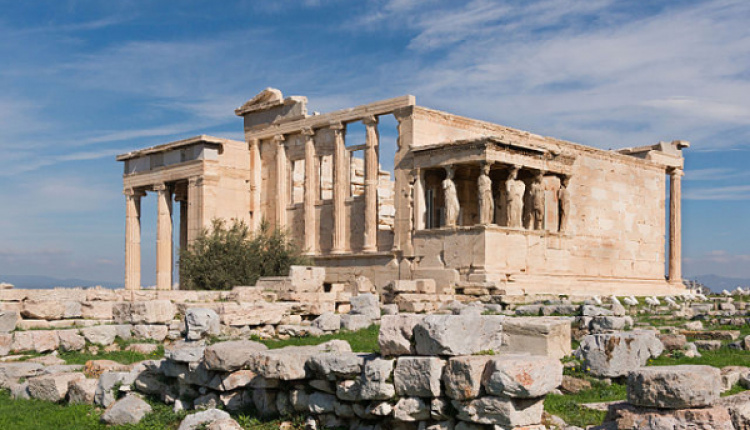The Best-Kept Secret Of Acropolis
- by XpatAthens
- Friday, 03 November 2023

The Acropolis of Athens naturally sends eyes skyward to take in the glories of the Parthenon and other buildings atop it, but its best-kept secret is a chamber inside the sacred rock.
The secret chamber of the Acropolis is actually a Byzantine church. Restored in 2017, the Acropolis, once a place of worship, burrows deep into the base of Athens’ most renowned mountain. Above the Dionysus Theater, is the church called Panagia Spilotissa, or the Virgin Mary of the Cave, which was converted from an archaic temple.
Ironically, the church originated as a temple to celebrate the ancient Greek god of festivity and religious madness. Dating back to 320 BC, the cave was a temple dedicated to Dionysus, built by Thrasyllos. Two Ionian pillars still stand on top of the entryway, easily spotted from the pedestrian walkway, the Dionysios Areopagitis, that borders the Acropolis.
Acropolis’ Secret: First an Archaic Monument, Then an Alternative Church
The monument was erected to celebrate Thrasyllos’ victory as the benefactor of a chorus that performed in the annual dramatic festival that honored Dionysus. After the victory, Thrasyllos had the monument constructed. It was again modified in 297 BC, following his son, Thrasyklis, victory to include inscriptions.
The cave was most likely considered sacred long before the construction of the monument. It may have been dedicated to Artemis, the goddess of the hunt. The rock face was cut back to form a flat vertical surface, and the mouth of the cave was enlarged into a rectangular opening. Two broad stone steps led up to the entry.
A Doric marble portico was set at the front of the cave, in imitation of the Propylaea, on the southwest wing of the Acropolis. The structure would have been surmounted with three bronze tripods that served as the actual prizes in the annual competition that involved drama, comedy, and musical performances. The tripods were eventually replaced with a statue of Dionysus.
Best-Preserved Examples of post-Byzantine Hagiography
“The fresco decoration of Panagia Spiliotissa comprises the best-preserved examples of post-Byzantine hagiography in the area of the Acropolis and its slopes,” according to Dr. Konstantinos Boletis. Boletis serves as a restoration architect for the Department/Ephorate of Antiquities of the City of Athens.
The church was one of the “alternative” places to worship that began to emerge in Athens during the sixth century following the decrees sent down by the Byzantine emperors.
To read this article in full, please visit: greekreporter.com
The secret chamber of the Acropolis is actually a Byzantine church. Restored in 2017, the Acropolis, once a place of worship, burrows deep into the base of Athens’ most renowned mountain. Above the Dionysus Theater, is the church called Panagia Spilotissa, or the Virgin Mary of the Cave, which was converted from an archaic temple.
Ironically, the church originated as a temple to celebrate the ancient Greek god of festivity and religious madness. Dating back to 320 BC, the cave was a temple dedicated to Dionysus, built by Thrasyllos. Two Ionian pillars still stand on top of the entryway, easily spotted from the pedestrian walkway, the Dionysios Areopagitis, that borders the Acropolis.
Acropolis’ Secret: First an Archaic Monument, Then an Alternative Church
The monument was erected to celebrate Thrasyllos’ victory as the benefactor of a chorus that performed in the annual dramatic festival that honored Dionysus. After the victory, Thrasyllos had the monument constructed. It was again modified in 297 BC, following his son, Thrasyklis, victory to include inscriptions.
The cave was most likely considered sacred long before the construction of the monument. It may have been dedicated to Artemis, the goddess of the hunt. The rock face was cut back to form a flat vertical surface, and the mouth of the cave was enlarged into a rectangular opening. Two broad stone steps led up to the entry.
A Doric marble portico was set at the front of the cave, in imitation of the Propylaea, on the southwest wing of the Acropolis. The structure would have been surmounted with three bronze tripods that served as the actual prizes in the annual competition that involved drama, comedy, and musical performances. The tripods were eventually replaced with a statue of Dionysus.
Best-Preserved Examples of post-Byzantine Hagiography
“The fresco decoration of Panagia Spiliotissa comprises the best-preserved examples of post-Byzantine hagiography in the area of the Acropolis and its slopes,” according to Dr. Konstantinos Boletis. Boletis serves as a restoration architect for the Department/Ephorate of Antiquities of the City of Athens.
The church was one of the “alternative” places to worship that began to emerge in Athens during the sixth century following the decrees sent down by the Byzantine emperors.
To read this article in full, please visit: greekreporter.com


